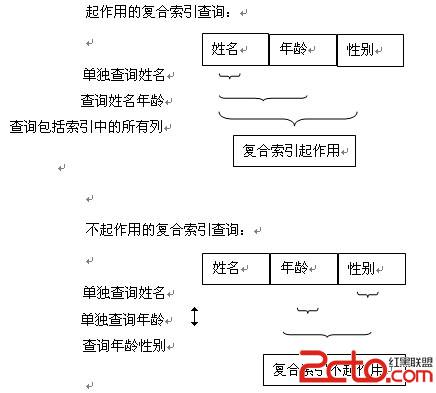mysql聯合索引詳解
聯合索引又叫復合索引。對於復合索引:Mysql從左到右的使用索引中的字段,一個查詢可以只使用索引中的一部份,但只能是最左側部分。例如索引是key index (a,b,c). 可以支持a | a,b| a,b,c 3種組合進行查找,但不支持 b,c進行查找 .當最左側字段是常量引用時,索引就十分有效。
兩個或更多個列上的索引被稱作復合索引。
利用索引中的附加列,您可以縮小搜索的范圍,但使用一個具有兩列的索引 不同於使用兩個單獨的索引。復合索引的結構與電話簿類似,人名由姓和名構成,電話簿首先按姓氏對進行排序,然後按名字對有相同姓氏的人進行排序。如果您知 道姓,電話簿將非常有用;如果您知道姓和名,電話簿則更為有用,但如果您只知道名不姓,電話簿將沒有用處。
所以說創建復合索引時,應該仔細考慮列的順序。對索引中的所有列執行搜索或僅對前幾列執行搜索時,復合索引非常有用;僅對後面的任意列執行搜索時,復合索引則沒有用處。
如:建立 姓名、年齡、性別的復合索引。
create table test(
a int,
b int,
c int,
KEY a(a,b,c)
);
優: select * from test where a=10 and b>50
差: select * from test where a50
優: select * from test order by a
差: select * from test order by b
差: select * from test order by c
優: select * from test where a=10 order by a
優: select * from test where a=10 order by b
差: select * from test where a=10 order by c
優: select * from test where a>10 order by a
差: select * from test where a>10 order by b
差: select * from test where a>10 order by c
優: select * from test where a=10 and b=10 order by a
優: select * from test where a=10 and b=10 order by b
優: select * from test where a=10 and b=10 order by c
優: select * from test where a=10 and b=10 order by a
優: select * from test where a=10 and b>10 order by b
差: select * from test where a=10 and b>10 order by c
 索引原則
1.索引越少越好
原因:主要在修改數據時,第個索引都要進行更新,降低寫速度。
2.最窄的字段放在鍵的左邊
3.避免file sort排序,臨時表和表掃描.
索引原則
1.索引越少越好
原因:主要在修改數據時,第個索引都要進行更新,降低寫速度。
2.最窄的字段放在鍵的左邊
3.避免file sort排序,臨時表和表掃描.